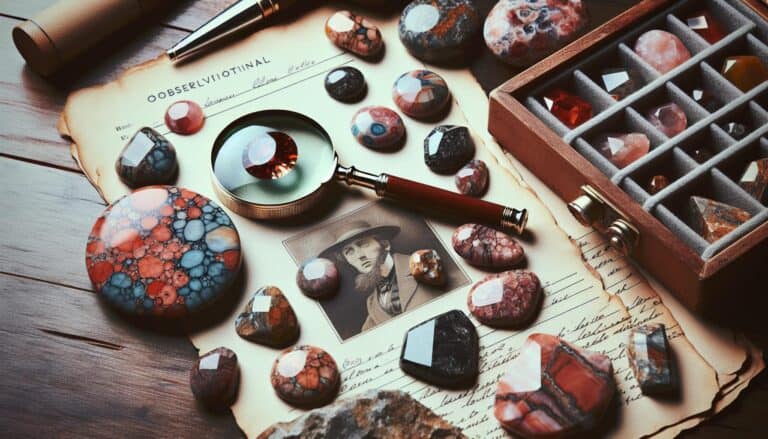Unearthing the mysteries of gemstones can be as thrilling as discovering treasure.
You’re about to dive into the world of charoite, a rare and captivating mineral known for its vibrant purple hues and intricate patterns. Whether you’re a seasoned collector or a curious newcomer, identifying charoite is an essential skill that’ll enhance your gemstone knowledge.
With its swirling shades of violet and deep purple, charoite isn’t just another pretty stone; it’s a gem with character. You’ll learn the key characteristics that set charoite apart from other minerals. From its unique texture to its unmistakable luster, getting to know charoite is an adventure in itself.
So grab your magnifying glass, and let’s get started on your journey to becoming a charoite identification pro.
To identify real charoite, look for its distinctive purple color with swirling patterns, light purple to white streak, and translucency. Charoite is non-magnetic, has a Mohs hardness of 5-6, shows no double refraction, and has a specific gravity of 2.54-2.78.
How to Identify Charoite Through Testing
When you’re fascinated by the stunning hues of charoite, learning to identify this gemstone through precise testing is both exciting and essential. Conducting a series of tests will enhance your ability to differentiate charoite from look-alikes and confirm its authenticity.
Visual Inspection
Start with a thorough Visual Inspection. Look for charoite’s characteristic purple color which simply stands out with swirling patterns of fibrous bands. These bands are typically interlaced with white, pearly streaks or occasionally inclusions that resemble landscapes. High-quality specimens showcase a silky luster that’s quite enchanting.
The Streak Test
The streak test is your next step. This simple procedure involves rubbing the stone across an unglazed porcelain tile to observe the color of its streak. Charoite typically leaves a light purple to white streak which can further confirm its identity.
Magnet Test
Although not commonly known, the Magnet Test can be telling. Charoite is not magnetic, so if your specimen is drawn to a magnet, it’s likely an imposter. Remember, magnetism in a stone purported to be charoite should raise an immediate red flag.
Hardness Test
Consult the Mohs scale for the Hardness Test. Charoite ranks at a 5 to 6, meaning it can scratch glass and be scratched by harder materials. Carefully scratch an inconspicuous area to avoid any potential damage to the stone.
Birefringence Test
Charoite possesses birefringence, or double refraction, a feature observable under a polariscope. Rotate the stone and watch for the alternating light and dark patterns that indicate its birefringent nature.
Checking The Diaphaneity
Examine the diaphaneity — the stone’s transparency or translucency. Charoite typically displays translucency when held against the light, a factor that helps distinguish it from other minerals.
Single or Double Refraction
Utilizing a refractometer, verify if charoite shows Single or Double Refraction. True charoite has double refraction where you’d see two shadows or images of the back facet edges within the stone.
Refractive Index Test
Carry out the Refractive Index Test to measure how much the stone bends light. Charoite’s refractive index ranges around 1.55 to 1.56 which can be measured with a refractometer and helps accurately identify the gemstone.
Finding The Specific Gravity
Determine the specific gravity by weighing the stone in air and then in water. The specific gravity of charoite lies between 2.54 to 2.78. This measurement can distinguish it from other minerals with similar appearance but different densities.
Identifying Charoites in the Field
When you’re outdoors, identifying charoites in the field requires a keen eye. Search for its distinctive color and patterns in areas known for their charoite deposits, predominantly in Siberia, Russia. Portable testing equipment can provide instant confirmation.
Recognizing Potential Charoite Rocks
Spotting potential charoite rocks involves checking for the typical purple hues, silky luster, and the unmistakable fibrous texture. Even in raw form, charoite’s unique appearance is an immediate indicator of its presence.
Physical Characteristics of Charoite

When you’re delving into the world of charoite, understanding its physical characteristics is crucial. Charoite is best known for its striking purple color which can range from soft lilac to deep purple with swirling patterns of white, black, and orange. This unique combination is not found in any other mineral, making charoite instantly recognizable to the seasoned collector.
In terms of luster, charoite typically has a pearly to vitreous shine, which can be observed under a light source. Its translucent to opaque clarity adds to its appeal, allowing various layers of color to shine through depending on the piece’s thickness.
Texture-wise, charoite is usually described as fibrous, with a somewhat silky feel. This is the result of its complex crystal structure, which often displays a chatoyancy or ‘cat’s eye’ effect when polished and cut appropriately. Recognizing this feature can help you spot genuine charoite amid imitations.
Lastly, don’t forget that charoite has a Mohs hardness of about 5 to 6, making it relatively soft and suitable for use in jewelry that doesn’t face constant abrasion. Keep this in mind as you examine pieces, noting any wear that might indicate softer mineral masquerading as this sturdy gem.
How Are Charoite Formed?
Embarking on a journey to understand the creation of charoite takes you deep into the realms of geological transformations. Charoite’s origin is as intriguing as its appearance. Charoite is formed from the alteration of limestone by the intrusion of igneous rocks through a complex process known as contact metamorphism. This rare event occurs when hot magma from the Earth’s mantle interacts with the cooler limestone, creating the unique conditions necessary for charoite to develop.
In these transformative environments, intense heat and pressure cause minerals within the limestone to re-crystallize. Charoite emerges from this chaotic ballet of elements as a result of the re-crystallization and chemical reaction between the lime-rich rock and the alkaline-rich fluids from the cooling magma. The process leads to the creation of this rare silicate mineral characterized by its vibrant purple color and intricate patterns.
It’s essential to note that the specific geological conditions needed for charoite formation are unique to the Sakha Republic (Yakutia) in Siberia, Russia. This exclusivity adds to the allure and rarity of charoite, making it a prized specimen for collectors and enthusiasts. The mineral’s dependence on such a distinct process means that finding charoite in other parts of the world is highly unlikely, further enhancing its value and significance in the gemstone market.
Understanding this formation process is crucial for identifying genuine charoite, as each piece tells a story of geological wonder. Witnessing the patterns of charoite is akin to peering into a visual representation of the Earth’s transformative power.
Preparation for Charoite Hunting
Gathering the Right Tools
Before you embark on your charoite hunting adventure, you’ll need to equip yourself with the right set of tools to facilitate both identification and collection.
- Magnifying glass or jeweler’s loupe: These are essential for a closer inspection of the stone’s unique patterns and textures.
- Geologist’s hammer: Handy for safely extracting samples if you’re allowed to.
- Field guide: An updated guide can provide visual references and aid in on-the-spot identification.
- Notebook and pen: Record your observations, including the location and characteristics of found specimens.
- Sample bags or containers: To store your charoite specimens while keeping them protected.
- Portable hardness test kit: You’ll be able to perform a preliminary hardness test on the field.
By preparing a comprehensive toolkit, you’re setting yourself up for successful identification and safe collection of charoite specimens.
Safety Considerations
Your safety should always come first. Here are some safety tips to keep in mind:
- Wear protective gear: Sturdy gloves and goggles are a must to protect you from sharp rocks and potential debris.
- Appropriate footwear: Strong, rugged boots will provide traction and support in rough terrain.
- Weather-appropriate clothing: Be ready for sudden climate changes, especially if you’re hunting in remote regions.
- First-aid kit: Essential for any outdoor activity to handle minor injuries promptly.
- Stay hydrated: Carry enough water especially when hunting in areas with limited access to fresh water supply.
- Inform someone: Make sure someone knows your plans and when you’re expected to return.
By prioritizing your safety, you’re not only protecting yourself but also ensuring that your charoite hunting experience is enjoyable and worry-free. Keep these precautions in mind while planning your trip – and you’re off to a great start.
Handling and Care of Found Charoite

Once you’ve successfully identified and collected charoite specimens, it’s crucial to understand the proper handling and care techniques to protect these valuable stones. A solid routine ensures your charoites maintain their stunning appearance and prevents potential damage.
Cleaning Charoites
When cleaning charoite, gentle methods are key. Avoid chemicals, ultrasonic cleaners, or steamers that can damage the stone’s unique lustre and coloration. Here’s how to safely clean your charoite:
- Use a soft, lint-free cloth lightly dampened with warm water.
- Gently wipe the surface of the stone to remove any dirt or debris.
- For ingrained dirt, use a soft-bristled brush like a toothbrush and lightly scrub the stone.
- Rinse with clean water being careful not to soak the stone which could cause it to become oversaturated.
- Air dry the charoite or use a soft towel to pat it dry.
Be sure to clean your charoite as soon as you return from your hunting expedition to prevent any substances from settling into the stone’s natural crevices.
Storing Charoites
Proper storage is as important as cleaning to maintain charoite’s integrity. Remember, even with a Mohs hardness rating of 5-6, charoite can still be scratched by harder materials. Here are storage tips to extend the life of your charoite:
- Store each piece of charoite separately to avoid scratches or chipping.
- Wrap the stones in a soft cloth or place them in a fabric-lined jewelry box.
- Keep charoites away from direct sunlight and excessive heat, which can fade the stone’s vibrant colors.
- Avoid storing charoites in damp environments to prevent weakening of the stone.
By carefully cleaning and thoughtfully storing your charoites, you ensure they remain as captivating as the moment you found them. Remember to inspect the stones regularly for any potential damage and address issues immediately, which helps sustain the allure of your collection over time.
Conclusion: Confirming Charoite is Real
Armed with the knowledge of charoite’s unique characteristics and the appropriate testing methods, you’re now equipped to confidently identify this captivating gemstone.
Remember, the key to distinguishing genuine charoite lies in its striking purple hues and intricate patterns. By applying the tests you’ve learned, from visual inspection to specific gravity determination, you’ll be able to authenticate your specimen with certainty. Don’t forget the importance of proper care—handling your charoite gently and storing it correctly will preserve its allure for years to come. Whether you’re a seasoned collector or a curious newcomer, the beauty of charoite is undeniable, and your ability to identify and maintain this gemstone is now part of your skill set.
Enjoy the journey of discovery and the satisfaction that comes with knowing you have a true piece of nature’s art.


![Michigan Rockhounding Sites in [year]: Spots & Treasures](https://observationhobbies.com/wp-content/uploads/2024/01/uHnd2EP5AFNXWL3ZMEMBT-768x439.jpg)

![Iowa Rockhounding Sites in [year]](https://observationhobbies.com/wp-content/uploads/2024/01/i4AXVDfMyunGn1zPZ8-9V-768x439.jpg)


